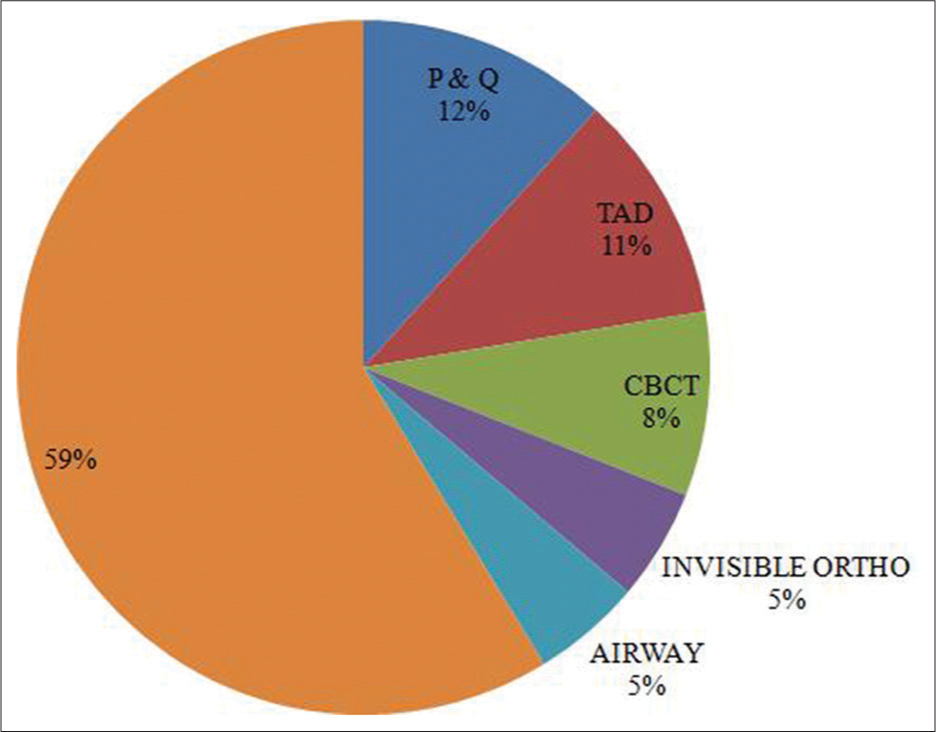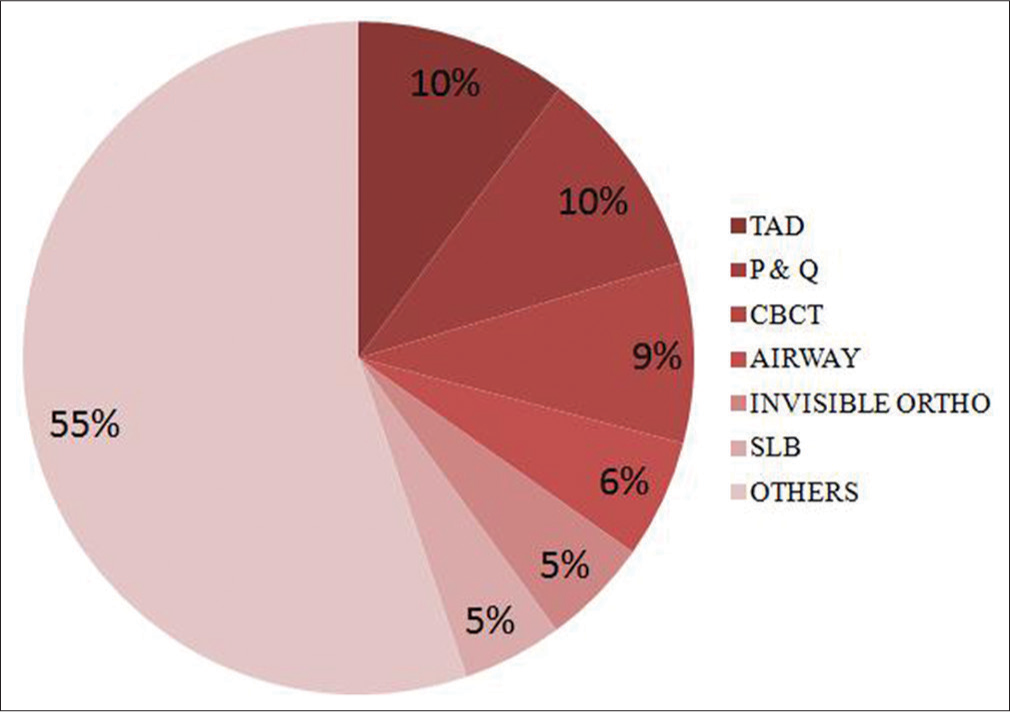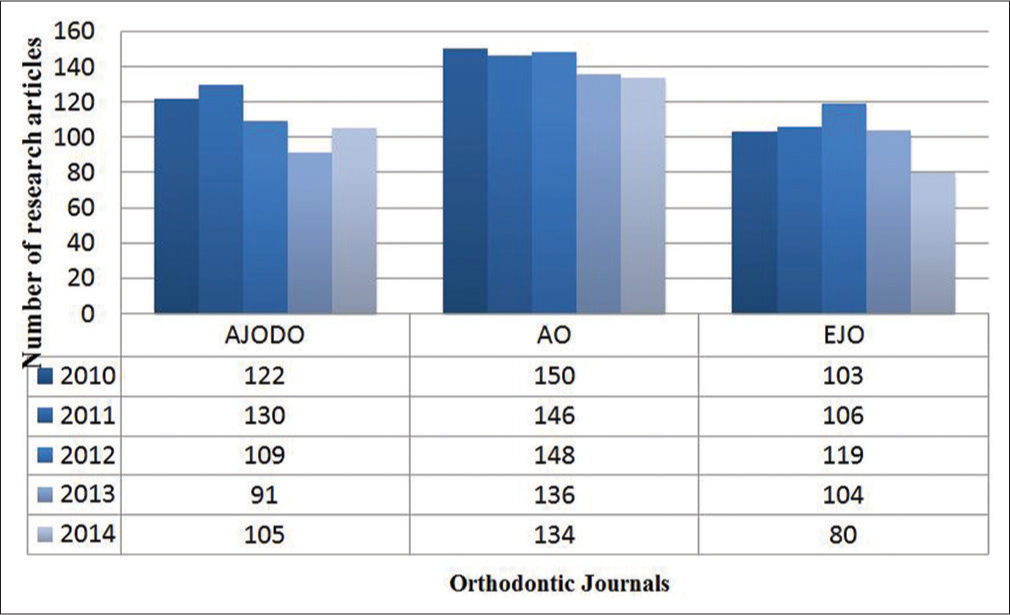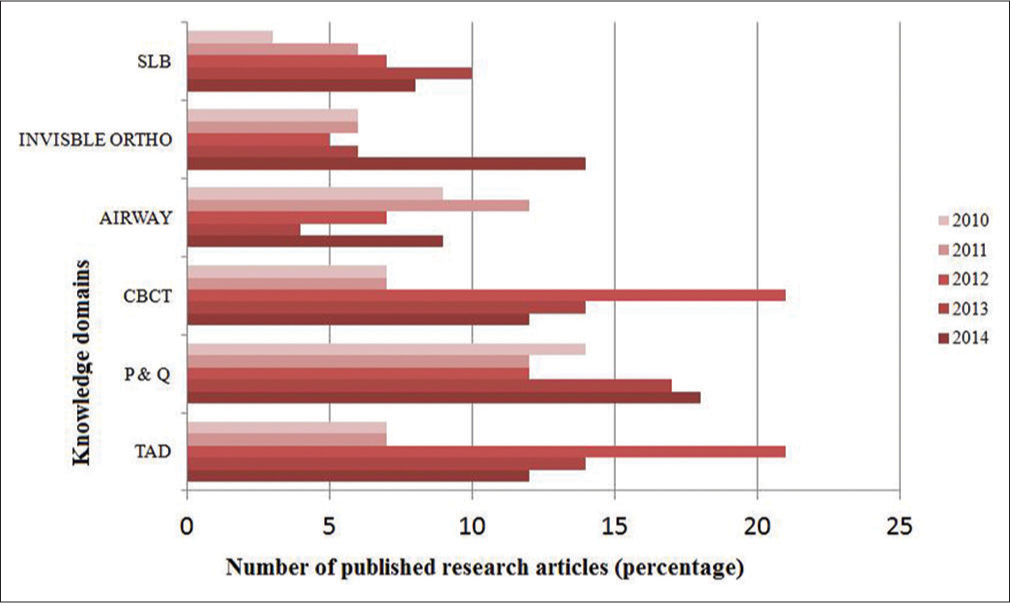Translate this page into:
Trends in Contemporary Orthodontic Research Publications: Evaluation of Three Major Orthodontic Journals
Address for correspondence: Dr. Ashish Handa, Air Force Dental Centre, Palam, Delhi Cantt, New Delhi - 110 010, India. E-mail: dr.ashish. 13@gmail.com
This article was originally published by Wolters Kluwer and was migrated to Scientific Scholar after the change of Publisher.
Abstract
Background
In this study, we aimed to evaluate the inclination of orthodontic research published in original articles in three of the most popular and recognized orthodontic journals with high impact factor; American Journal of Orthodontics and Dentofacial Orthopedics (AJODO), the Angle Orthodontist (AO), and European Journal of Orthodontics (EJO) published in a 5-year duration time frame (2010–2014).
Materials and Methods
Online search with supplementary hand searching was undertaken for original research articles in these three orthodontic journals from 2010 to 2014. Classification of data was completed autonomously by manual and direct appraisal of the manuscript of each journal.
Results and Conclusion
Three thousand one hundred and forty articles published in AJODO, AO, and EJO in the particular time period were selected, out of which 1783 original research study articles (56.78%) were appraised for classification in their various respective knowledge domains. AO (82.73%) and EJO (76.99%) were relatively more committed toward publication of research work in comparison to AJODO (34.55%). Research articles based on perception and questionnaires (12%), temporary anchorage devices (11%), cone-beam computed tomography (8%), invisible orthodontics (lingual orthodontics, clear aligners, esthetic brackets, and wires) (5%), and airway examination (5%) were the five most recurrently selected subjects of interest (41%) in these three journals during the observation period. The total number of research articles published in the three journals reduced statistically significantly in 2014 when compared to 2010.
Keywords
Article characteristics
orthodontic journals
research articles
study domain

[SHOW_RELATED_PUBMED_ARTICLES]
Introduction
The rising need for formatting and systematizing information garnered from the scientific and scholastic sphere has permitted healthcare researchers to evaluate scientific result in unparalleled illustrated manner.
Although clinical orthodontics has already achieved unprecedented heights, ranging from several diagnostic measures, effectual treatment mechanisms, more pragmatic vision on the retention and relapse and the methodical analysis of adverse effects during orthodontic treatment, this does not incur that more research and development is superfluous or undesired. New conception, skill, and methodology intending to advance, upgrade and augment a particular scientific turf must be pioneered first through their publication in prominent scientific journal.[1] Bibliometrics comes into sight as an imperative tool that facilitates one to plan and create various markers of information dissemination and knowledge.[2-4]
Journals characterize the principal foundation of knowledge in a particular field.[5] The world’s foremost dental journal, the American Journal of Dental Science, commenced its publication in 1839.[6] Since then, the periodicals in the branch of dentistry have been acting as a medium of knowledge and means of communication within the dental fraternity and other disciplines.
In the past decade or so, there has been a remarkable increase in the number of orthodontic journals, with orthodontic literature evolving to incorporate more hierarchical evidence. Fundamental research studies have been on the rise, and comprehensive aspects of orthodontic focus such as biomechanics have been handled from the clinical and technical perspective. Highly competent research on orthodontic matters is also being published in key biomedical periodicals; however, the major chunk of orthodontic literature available to clinicians remains to be limited within the orthodontic journals.[7]
The increasing number of orthodontic periodicals worldwide entails the keen curiosity of specialty institutes and publishers in this sphere. However, there is a probability of a double-edged sword scenario as the accessibility of various orthodontic journals raises a query regarding the scientific worth and significance of each journal’s matter. The influence of a scientific periodical can be reflected by its citedness as defined by the impact factor (IF) and its acknowledgment as predicted by its circulation,[8-10] though some authors have a different view over it.[11,12] The science edition of Journal Citation Reports (JCRs) offers an objective and systematic way of appraising the foremost comprehensive journals critically, with computable, statistical information based on citation records.[13]
The aim of this study was to highlight the key focus of research interest in orthodontics during a recent 5-year time period (2010–2014) in three major orthodontic journals with high IF. We considered the number and the type of research articles in these admired orthodontic journals to present a general overview of the in-progress published data dealing with orthodontics or coming from orthodontic divisions.
Materials and Methods
Web editions and print copies of articles published in American Journal of Orthodontics and Dentofacial Orthopedics (AJODO), European Journal of Orthodontics (EJO), and Angle Orthodontist (AO) from 2010 to 2014 were scrutinized for original research studies.
The exclusion criteria comprised editorials, letters to the editor, interviews, biographies, comments, historical articles, case reports, and reviews with orthodontic content so that we retrieved only original articles pertaining to research happening worldwide in the field of orthodontics. Systematic reviews and meta-analysis were also excluded from the study as they involve interpretation of data salvaged from combined research articles related to a specific subject of interest.
The IFs of the three professional orthodontic journals were taken from the 2013 JCR-AJODO (1.437), AO (1.277), and EJO (1.390).[14] Table 1 shows the variance in IF scores of these journals based on the data from their publishers and the science edition of JCR during the entire observation period. The full texts were primarily retrieved from PubMed, the online AO, and science direct. Classification of data was accomplished autonomously by manual and direct appraisal of the manuscript of each journal by two orthodontists independently and concurrently. Their performance was analyzed by means of the Kappa test, of which result was κ = 0.9726 (nearly perfect agreement).
| Journal | 2010 | 2011 | 2012 | 2013 | 2014 |
|---|---|---|---|---|---|
| AJODO | 1.354 | 1.381 | 1.458 | 1.437 | 1.382 |
| AO | 1.000 | 1.207 | 1.184 | 1.277 | 1.225 |
| EJO | 0.932 | 0.893 | 1.078 | 1.390 | 1.483 |
*IF scores (JCR) throughout observation period (2010-2014). AJODO – American Journal of Orthodontics and Dentofacial Orthopedics; AO – Angle Orthodontist; EJO – European Journal of Orthodontics; IF – Impact factor; JCR – journal citation reports
Results
Total number of articles published in these three orthodontic journals during the entire observation period were found to be 3140 (AJODO [n = 1612], the AO [n = 863], and EJO [n = 665]). A total of 1783 (56.78%) original study articles pertaining to research (AJODO [n = 557], AO [n = 714] and EJO [n = 512]) were selected based on our inclusion criteria [Figure 1]. Figure 2 depicts the percentage of research articles published in the three journals in the last 5 years. Notably, AO (82.73%) and EJO (76.99%) published as many as twice original research articles relative to AJODO (34.55%).

- Distribution of total number of articles and number of research articles in the three journals

- Percentage of research articles in the three journals
Five significant domains that comprised the major proportion (41%) of all this research interest were as follows [Figure 3]:

- Overall topic-wise distribution (percentage) of research articles
Perception and questionnaires (P and Q) (12%)
Temporary anchorage devices (TADs) (11%)
Cone-beam computed tomography (CBCT) (8%)
Invisible orthodontics (lingual orthodontics, clear aligners, esthetic brackets, and wires) (5%)
Airway (5%).
Apart from these research parameters, cariology (5%) was another domain that deserved attention among the AJODO original articles [Figure 4]. Significant number of research studies were also published on self-ligating brackets (SLB) (5%) in AO in these 5 years [Figure 5]. However, there were no exceptions among the EJO articles [Figure 6].

- Topic-wise distribution (percentage) of research articles in American Journal of Orthodontics and Dentofacial Orthopedics

- Topic-wise distribution (percentage) of research articles in Angle Orthodontist

- Topic-wise distribution (percentage) of research articles in European Journal of Orthodontics
Figure 7 illustrates the year-wise publication of the number of research articles in these three well-accepted journals during the study period, depicting a moderate decline in terms of their number, probably because of the meta-analysis and systematic review studies too gaining worldwide acceptance.[15,16]

- Year-wise distribution of research articles in the three journals
We also attempted to figure out the trend in research designs in all these three journals from 2010 to 2014. Only the number of research articles on CBCT in AJODO showed a significant increase in frequency of publication in 2014 in comparison to 2010 [Figure 8]. On the other hand, in EJO, research articles on P and Q, TADs, and CBCT rose in 2014 [Figure 9]. AO was the only journal showing a reasonable increase in research articles in all the aforesaid topics of orthodontic interest [Figure 10].

- Year-wise distribution of knowledge domains in American Journal of Orthodontics and Dentofacial Orthopedics

- Year-wise distribution of knowledge domains in European Journal of Orthodontics

- Year-wise distribution of knowledge domains in Angle Orthodontist
Discussion
Evidence-based clinical judgment inexorably relies on the accessibility of high-quality evidence, which can only be the result of extensive research. Journals not only constitute the most vibrant method employed to disseminate knowledge in dental specialty domain but are also a markedly vital communication medium for science. Apart from conveying the scientific output of a specific region, they pose paramount credibility and extensive dissemination of knowledge among the dental fraternity.[17] Several measures have been proposed by which the influence of a particular periodical can be verified such as the citation index, computed by IF or by its extensive acceptance as specified by how widely it circulates.
Various bibliometric studies have been published in several fields of dentistry, including pediatric dentistry,[4,18,19] endodontology,[20] periodontology,[21] implantology,[22,23] prosthodontics,[24,25] maxillofacial surgery,[26,27] and orofacial pain.[28] Even in orthodontics, few studies on bibliometrics or citation analysis have been reported.[7,29-32]
The present study performs a bibliometric analysis of orthodontic literature with the rationale of characterizing scientific output in the original research study articles in three of the most sorted and high IF orthodontic journals from 2010 to 2014.
Unlike some other studies,[19,30] where only the title and abstract were investigated to classify the articles, this study was carried out by two orthodontists, who explored the whole manuscript independently and concurrently to inculcate reliability to the evaluation and evade measurement bias.
Out of the 3140 published articles in AJODO, AO, and EJO in the chosen time frame, 1783 original research study articles were selected and scrutinized for classification in their various respective knowledge domains. Thus, it was noted that 56.78% of the articles pertained to original research work, which is still a substantial figure, considering the fact that lately systematic reviews and meta-analysis have attracted many orthodontists’ attention.[31]
Although AO (82.73%) and EJO (76.99%) showed considerable affinity toward research work, AJODO (34.55%) was generous enough to incorporate other domain articles too. Kanavakis et al.[32] in 2006 conducted a similar bibliometric study on these three journals and concluded that 93.7% of articles published in EJO are research studies, whereas these articles comprise 67.7% in AJODO and 65.69% in AO. Changes over time in article types were primarily in AO and EJO with both journals accepting significantly more research articles as compared to AJODO. In another study,[29] it was examined that EJO and AO published more research articles, whereas AJODO often published case reports and other articles in the time interval of 2008–2012.
Evaluating the number of publications on original research work year wise, it can be noticed that the figure has dropped in all the three journals in 2014 (AJODO [n = 105], AO [n = 134], and EJO [n = 80]) when compared to 2010 (AJODO [n = 122], AO [n = 150] and EJO [n = 103]). Primo et al.[30] in their bibliometric analysis found cohort (23.9%) and cross-sectional (21.7%) study designs to be the most frequent in AJODO. In the Brazilian journal, however, cross-sectional studies demonstrated a 28.6% frequency, with reviews of literature ranking second with 24.6%.
It is worth noting that the AJODO is a monthly publication, whereas AO and EJO are bimonthly periodicals. Access to the online publications of AO is free of cost. On the contrary, online contents of AJODO and EJO are exclusively accessible for libraries or members.
An insight into the publishing trends of various journals can help clinicians to identify those are best suited to meet their needs. Out of all the research work published in these three journals during the observation period, articles on P and Q, TAD, CBCT, invisible orthodontics (lingual orthodontics, clear aligners, esthetic brackets, and wires), and airway examination gained the five topmost significant rankings in terms of their frequency of publication.
P and Q, TAD, and CBCT retained the top 3 slots in attracting research enthusiasts in AJODO and AO whereas invisible orthodontics replaced CBCT for the third ranking in respect of publications in research in EJO. These findings though are not in concurrence with a study conducted by Primo et al.[30] for a 10-year period (1999–2004–2009) concluded that the topics most often investigated were dental materials (17%) and treatment devices (12.4%) in AJODO. A plausible explanation for this recent high percentage of P and Q studies is the ever increasing weightage being given to what exactly the common person perceives regarding his or her outlook and basically what in particular are they expecting on the completion of their orthodontic treatment.[33,34] Moreover, they evaluated all the published articles rather than considering only the original research ones.
TADs have increased the envelope of orthodontic treatment by providing absolute means of anchorage and have attracted great attention in recent years because of their small size, versatility, minimal surgical invasiveness, instant loading, and low cost.[35-37] CBCT too has become increasingly essential in treatment planning and diagnosis, particularly in cases concerning temporomandibular joint (TMJ) disorders, airway and sinus health, ectopic eruption patterns, incidental pathology, transverse asymmetries, and true root positioning;[38,39] with most published articles (14%) exercising it as a diagnostic tool in AJODO.
While invisible orthodontics’ popularity did not come as much of a surprise, there is a promising focus on airway and sinus health-related research and studies pertaining to obstructive sleep apnea risk and management; as people are getting increasingly aware of its deleterious effects and benefits of timely intervention.[40,41]
There was also an increasing trend toward the publication of research articles on cariology and in particular, prevention and cure of white spot lesions (WSL) in AJODO periodicals. The prevalence of WSL, considered being the precursor of enamel caries, has been reported to be between 4.9% and 84%[42] and is thus a grave concern to orthodontists and patients.
There has been resurgence in the application of SLB as indicated by significant studies aimed at assessing their efficacy and therapeutic characteristics published in AO.[43-45]
Apart from the 41% share of research credited to the aforementioned five knowledge domains, the remaining 59% of research articles comprised mainly of studies based on need for orthodontic treatment, genetics, TMJ, orthognathic surgeries, treatment devices, three-dimensional imaging, orthodontic materials, morphology, pathology, and treatment mechanics. Mavropoulos and Kiliaridis[7] in 2003 on assessing the orthodontic journals from 1981 to 2000 reported that articles increasingly concentrated on treatment evaluation and diagnosis. In another study,[46] out of all the articles published between 1999 and 2008, 425 were randomly analyzed so as to establish the publishing profile of four international orthodontic periodicals. Articles on growth and development, diagnosis, and management accounted for 72.2% of the articles scrutinized. Harrison et al.[47] reported considerable differences in the content of international journals of orthodontics, implying that an insight into the publishing inclination of various journals can facilitate clinicians to recognize journals that are best suited to meet their requirements. Another recent study[48] exploring the demography of publications in South Asian orthodontic journals in the last 6 years found cross-sectional studies outnumbering randomized controlled trials and systematic reviews/meta-analysis articles.
The outcome of this study and selection of these journals are not intended to qualitatively evaluate the general content of the journal. Furthermore, the analysis of the results does not declare that valuable sound scientific information cannot be gained from non-IF journals. A considerable portion of orthodontic research nowadays is published in general dental and basic science periodicals or engineering journals such as Journal of Biomechanics, Immunology, Journal of Biological Chemistry, Journal of Biomedical Materials Research, Journal of Anatomy and Bone, among others (due to high IF).[7] Hence, the revelation of the present findings should not be generalized to periodicals not included in this study to minimize any publication bias.
Conclusion
AO and EJO published more research study articles in comparison to AJODO (2010–2014)
Questionnaires, TAD, CBCT, invisible orthodontics, and airway-oriented articles mostly published
Number of published research articles reduced in 2014 when compared to 2010
Considerable research articles on cariology and SLB too.
Financial support and sponsorship
Nil.
Conflicts of interest
There are no conflicts of interest.
References
- Impact factor. A review with specific relevance to orthodontic journals. J Orofac Orthop. 2001;62:74-83.
- [Google Scholar]
- Bibliometric Indicators and Analysis of Research Systems Methods and Examples. Paris: OCDE; 1997.
- Benchmarking the endodontic literature on MEDLINE. J Endod. 2001;27:470-3.
- [CrossRef] [PubMed] [Google Scholar]
- A bibliometric analysis of the pediatric dental literature in MEDLINE. Pediatr Dent. 2001;23:415-8.
- [Google Scholar]
- Creating and disseminating knowledge among organizational scholars: The role of special issues. Organ Sci. 2004;15:120-9.
- [Google Scholar]
- Orthodontic literature: An overview of the last 2 decades. Am J Orthod Dentofacial Orthop. 2003;124:30-40.
- [Google Scholar]
- Dispelling a few common myths about journal citation impacts. Scientist. 1997;11:11.
- [Google Scholar]
- The citedness of publications by U.K. library schools. J Inf Sci. 1995;21:68-71.
- [CrossRef] [PubMed] [Google Scholar]
- A bibliometric study on aging and reception processes of scientific literature. J Inf Sci. 1995;21:37-53.
- [CrossRef] [Google Scholar]
- Why the impact factor of journals should not be used for evaluating research. BMJ. 1997;314:498-502.
- [CrossRef] [PubMed] [Google Scholar]
- Journal Citation Reports. Available from: http://www.wokinfo.com/products_tools/analytical/jcr/. [Last accessed on 2011 Nov 02]
- Journal Citation Reports. Available from: http://www.citefactor.org/journal-impact-factor-list-2014.html. [Last accessed on 2017 Aug 31]
- Randomization in clinical trials in orthodontics: Its significance in research design and methods to achieve it. Eur J Orthod. 2011;33:684-90.
- [CrossRef] [PubMed] [Google Scholar]
- Issues in outcomes research: An over-view of randomization techniques for clinical trials. J Athl Train. 2008;43:215-21.
- [Google Scholar]
- Advanced orthodontic education: Evolution of assessment criteria and methods to meet future challenges. Angle Orthod. 2005;75:147-54.
- [Google Scholar]
- Exploring the profile of articles on traumatic dental injuries in pediatric dental journals. Dent Traumatol. 2013;29:172-7.
- [CrossRef] [PubMed] [Google Scholar]
- Bibliometric study of articles published in a Brazilian journal of pediatric dentistry. Braz Oral Res. 2010;24:83-8.
- [Google Scholar]
- Top-cited articles in endodontic journals. J Endod. 2011;37:1183-90.
- [CrossRef] [PubMed] [Google Scholar]
- Citation classics in periodontology: A controlled study. J Clin Periodontol. 2007;34:349-58.
- [CrossRef] [PubMed] [Google Scholar]
- Authorship, collaboration, and funding trends in implantology literature: Analysis of five journals from 2005 to 2009. Implant Dent. 2011;20:68-75.
- [CrossRef] [PubMed] [Google Scholar]
- Trends in funding, internationalization, and types of study for original articles published in five implant-related journals between 2005 and 2009. Int J Oral Maxillofac Implants. 2012;27:69-76.
- [Google Scholar]
- An analysis of prosthodontic research productivity: Geographic, economic, and collaborative perspective. J Prosthodont. 2012;21:73-8.
- [CrossRef] [Google Scholar]
- Authorship characteristics in prosthodontic literature: Proliferation and internationalization. A review and analysis following a 10-year observation. J Prosthet Dent. 2010;104:158-64.
- [CrossRef] [Google Scholar]
- What are we reading? A study of downloaded and cited articles from the British Journal of Oral and Maxillofacial Surgery in 2010. Br J Oral Maxillofac Surg. 2011;49:527-31.
- [Google Scholar]
- Full length articles published in BJOMS during 2010-11 – An analysis by sub-specialty and study type. Br J Oral Maxillofac Surg. 2012;50:749-56.
- [Google Scholar]
- World orofacial pain research production: A bibliometric study (2004-2005) J Orofac Pain. 2008;22:181-9.
- [CrossRef] [Google Scholar]
- Exploring the publications in three major orthodontic journals: A comparative analysis of two 5-year periods. Angle Orthod. 2014;84:397-403.
- [CrossRef] [PubMed] [Google Scholar]
- Bibliometric analysis of scientific articles published in Brazilian and international orthodontic journals over a 10-year period. Dental Press J Orthod. 2014;19:56-65.
- [CrossRef] [PubMed] [Google Scholar]
- Quantity and quality assessment of randomized controlled trials on orthodontic practice in PubMed. Angle Orthod. 2010;80:525-30.
- [CrossRef] [Google Scholar]
- Orthodontic journals with impact factors in perspective: Trends in the types of articles and authorship characteristics. Am J Orthod Dentofacial Orthop. 2006;130:516-22.
- [Google Scholar]
- Perceptions of dental professionals and laypersons to altered dental esthetics: Asymmetric and symmetric situations. Am J Orthod Dentofacial Orthop. 2006;130:141-51.
- [Google Scholar]
- The influence of maxillary gingival exposure on dental attractiveness ratings. Eur J Orthod. 2002;24:199-204.
- [CrossRef] [PubMed] [Google Scholar]
- Analysis of temporary skeletal anchorage devices used for en-masse retraction: A preliminary study. Am J Orthod Dentofacial Orthop. 2009;136:268-76.
- [Google Scholar]
- Effective en-masse retraction design with orthodontic mini-implant anchorage: A finite element analysis. Am J Orthod Dentofacial Orthop. 2010;137:648-57.
- [Google Scholar]
- Dosimetry of a cone-beam computed tomography machine compared with a digital X-ray machine in orthodontic imaging. Am J Orthod Dentofacial Orthop. 2012;141:436-43.
- [Google Scholar]
- Airway growth and development: A computerized 3-dimensional analysis. J Oral Maxillofac Surg. 2012;70:2174-83.
- [Google Scholar]
- Surgical modifications of the upper airway for obstructive sleep apnea in adults: A systematic review and meta-analysis. Sleep. 2010;33:1396-407.
- [CrossRef] [PubMed] [Google Scholar]
- White spot lesions after orthodontic treatment. Semin Orthod. 2008;14:209-19.
- [CrossRef] [Google Scholar]
- Treatment efficiency of conventional vs. self-ligating brackets: Effects of archwire size and material. Am J Orthod Dentofacial Orthop. 2007;131:395-9.
- [Google Scholar]
- Orthodontic treatment efficiency with self-ligating and conventional edgewise twin brackets: A prospective randomized clinical trial. Angle Orthod. 2012;82:929-34.
- [Google Scholar]
- What are we reading? An analysis of the orthodontic literature 1999 to 2008. Am J Orthod Dentofacial Orthop. 2011;139:e471-84.
- [CrossRef] [PubMed] [Google Scholar]
- An analysis of papers published in the British and European Journals of Orthodontics. Br J Orthod. 1996;23:203-9.
- [CrossRef] [Google Scholar]
- Demography of publications in South Asian Orthodontic Journals. J Indian Orthod Soc. 2017;51:87-91.
- [Google Scholar]





